| Incomplete Past I |

Alex de Vrede , "Who is Afraid of a Blue Tablecloth - The Second Act" 1992, oil on masonite, 106 x 54 cm.
|
During Alex de Vrede's exhibition, which was recently concluded to acclaim,
this somewhat older work (from 1992) entitled "Who is Afraid of a Blue
Tablecloth - The Second Act" surfaced.
This painting is a reference to the hullabaloo surrounding the damaged Barnett Newman painting called "Who's Afraid of Red, Yellow and Blue". Although some people see the perpetrator as a lunatic, he initially suggested that his act had been prompted by his frustration with the Stedelijk Museum's policy and, more in general, with the reception of decorative figuration meted out by the world of art. I remember that the perpetrator contacted me, asking me if I would be willing to provide him with thoroughly substantiated arguments in his defence before the court. We never got beyond the stage of an informal talk, though. At the trial which ensued, he argued by way of defence that damaging an existing work of art itself should be regarded as a work of art. Notwithstanding the generous attention devoted to the affair in the press, at the time of the original incident and later, when the perpetrator successfully attacked another painting, again at the Stedelijk Museum in Amsterdam, little attention has been devoted to the more fundamental backgrounds. That's too bad: as wretched and immature as this method of attention seeking is, if it's true that the motive can be traced back to existing contrasting positions within the world of art, wouldn't it have been the perfect opportunity for charting relations in an art history sort of context? I'll be the first to admit that this cannot possibly be as easy as it sounds, for art-oriented ideas are by definition underpinned by subjective experiences no matter how you look at them, and even this neutral contention is questioned by many of those involved. Just try it out for yourself among your own inner circle and you'll see what I mean. In his painting, Alex de Vrede has put past events into perspective using a painted pun (the cloth as a canvas or as a tablecloth), arranging his blue tablecloth around an empty frame in which reality is dramatically distorted in a shiny can. I hasten to add that De Vrede has nothing against Newman, nor is he in favour of any act of vandalism whatsoever. But then again, when do associations ever make sense? |
BACK